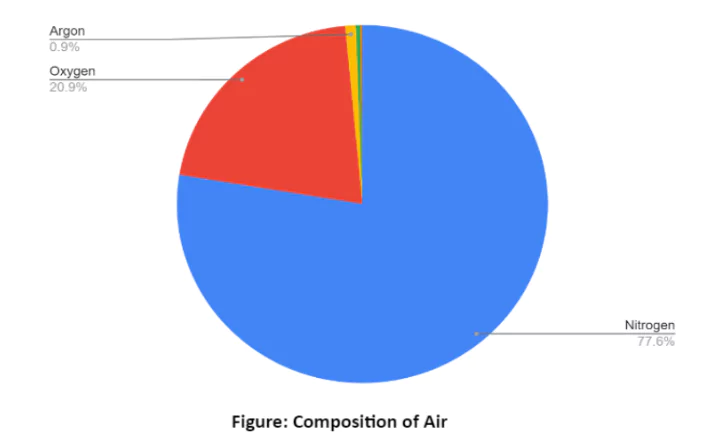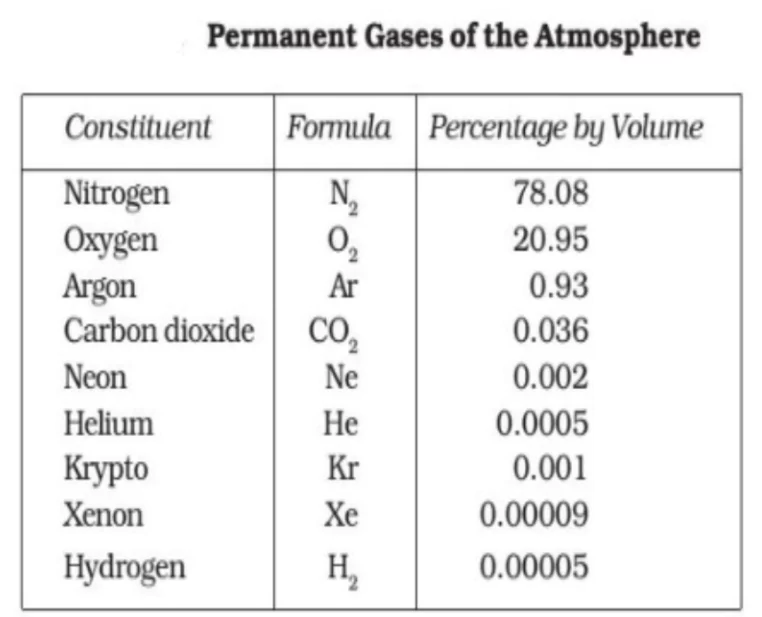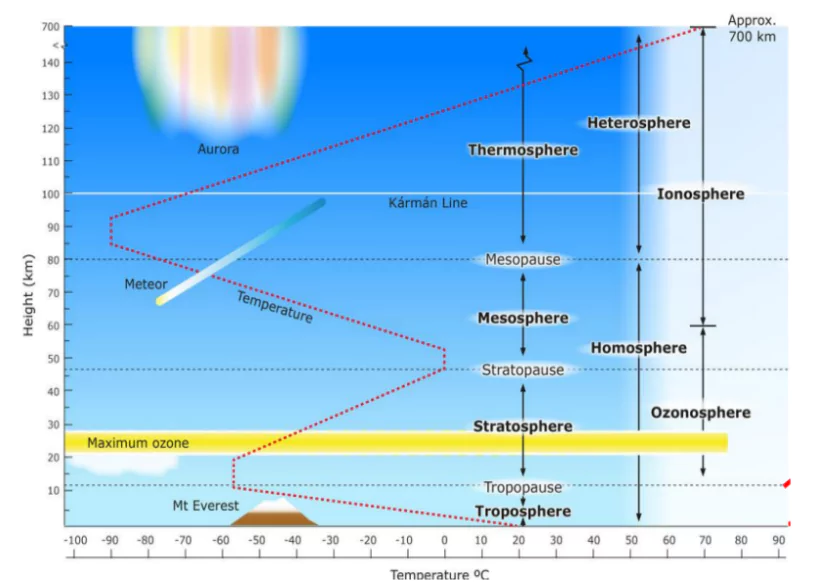The Earth’s atmosphere enveloping Earth is a blend of gases, water vapour, and dust particles. Oxygen, vital for breathing, and carbon dioxide, essential for plant growth, are prominent components. Within the lower atmosphere, their proportions vary, with oxygen nearly absent at 120 km altitude, and carbon dioxide and water vapor confined to heights below 90 km. This dynamic composition underscores the importance of understanding atmospheric layers for sustaining life on our planet.
Composition of the Atmosphere
- Mixture of Gases: The Earth’s atmosphere comprises a mixture of gases, water vapour, and dust particles.
 Concentration of Atmospheric Mass: 99% of the atmosphere’s total mass is concentrated within a range of 32 kilometers from the Earth’s surface.
Concentration of Atmospheric Mass: 99% of the atmosphere’s total mass is concentrated within a range of 32 kilometers from the Earth’s surface. - Composition of Various Gases: The Earth’s atmosphere consists mainly of permanent (Nitrogen– 78%, Oxygen-21% & Argon-0.93%) and variable gases (like Water vapour, carbon dioxide, ozone, hydrogen, helium, neon, xenon, krypton, methane, etc).
- Carbon dioxide(0.04%): Transparent to incoming solar radiation (short wave radiations) but acts as a greenhouse gas (opaque to long wave radiation).
- Argon: is a noble gas; the third most abundant gas in the earth’s atmosphere.
- Ozone: is present in the stratosphere; absorbs ultraviolet rays from the sun.
 Water Vapour: It is a variable gas that decreases with altitude. Water vapour also decreases from the equator towards the poles.
Water Vapour: It is a variable gas that decreases with altitude. Water vapour also decreases from the equator towards the poles.
- Water vapour is the most abundant greenhouse gas in the atmosphere which absorbs infrared rays emitted from the earth’s surface. [UPSC 2023].
- Dust Particles: These are more concentrated in subtropical and temperate regions due to dry winds.
Layers of Atmosphere
- The Earth’s atmosphere is divided into the following distinct layers.
- Troposphere: Lowest layer with an average height of 13 km. It extends up to approximately 8 km near the poles and about 18 km at the equator.
- All weather changes and biological activities occur in this layer.
- Temperature decreases with height at a rate of 1°C for every 165 meters of height.
Enroll now for UPSC Online Course
- Stratosphere: Located above the tropopause and extends to a height of 50 km. It contains the ozone layer, which absorbs UV rays.
- Temperature increases with height.
- Ideal for aircraft flying due to the minimal presence of water vapour & clouds except polar stratospheric clouds (responsible for ozone depletion).
- Influenced by subtropical and polar jetstreams.
 Mesosphere: Extends up to 80 km.
Mesosphere: Extends up to 80 km.
- Decreasing temperatures with altitude.
- The upper limit of the mesosphere is known as the mesopause (minimum temperature).
- Meteors and Shooting Stars occur here; GreenHouse Gases are absent.
- Ionosphere: This layer spans from 80 – 400 km above the mesopause; contains electrically charged particles and reflects radio waves back to Earth.
- It further has a D-Layer (lowest), an E-Layer and a F-Layer (F1 and F2 layers).
- Exosphere: uppermost layer of the atmosphere.
- Thermosphere: It is the Earth’s layer from 90 to 500-1,000 km.
- It is marked by the thermopause at 500-1,000 km. Solar-driven temperature variations; has low density resembling space; has auroras.
- Earth’s atmosphere is divided into homosphere and heterosphere.
- Homosphere, up to 60 miles, uniform mixture of air, well-mixed layers (Troposphere, Stratosphere)
- Heterosphere, beyond 60 miles, varying composition with distinct layers (Thermosphere, Exosphere) with minimal mixing, influenced by solar radiation and transitions into space.
Conclusion
- Earth’s atmosphere is a complex blend of gases, water vapour, and dust particles, crucial for sustaining life. With 99% of its mass concentrated within 32 km from the surface, it supports various layers, each with unique characteristics and roles.
- From the troposphere, where weather phenomena occur, to the thermosphere, where auroras dance in the sky, each layer contributes to the dynamic balance essential for our planet’s well-being.
![]() April 29, 2024
April 29, 2024
![]() 2054
2054
![]() 0
0
 Concentration of Atmospheric Mass: 99% of the atmosphere’s total mass is concentrated within a range of 32 kilometers from the Earth’s surface.
Concentration of Atmospheric Mass: 99% of the atmosphere’s total mass is concentrated within a range of 32 kilometers from the Earth’s surface.  Water Vapour: It is a variable gas that decreases with altitude. Water vapour also decreases from the equator towards the poles.
Water Vapour: It is a variable gas that decreases with altitude. Water vapour also decreases from the equator towards the poles.
 Mesosphere: Extends up to 80 km.
Mesosphere: Extends up to 80 km.